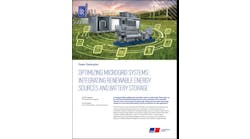First comes government support for new energy technologies. Then, if the technology proves out, come private investors. So it’s significant to note the launch this week of a new private firm to finance microgrids.
Crescendo Power has formed to offer an initial $30 million in equity financing for commercial and industrial microgrids and distributed generation projects in the 1-10 MW range.
The project investment company was founded by Coleman Adams and Todd Price, both previously of Hitachi.
Crescendo Power has pulled together a team of investors, among them a principal who is remaining anonymous for now and “is passionate about distributed generation, and microgrids in particular,” Price said in an interview.
“He’s a big believer that the utility industry hasn’t necessarily made all of the infrastructure investment into upgrades and capacity that we need,” Price said. “He’s a big believer in the resiliency attributes of microgrids. Not that he sees utilities going away. It’s just that he sees a market where in certain situations, distributed generation is going to make a lot of sense.”
To some, this may seem like an uncertain time to finance microgrids, as the Trump administration upends federal energy and environmental programs established over the last eight years.
Crescendo Power, however, sees the opposite as true. In an uncertain time, microgrids and distributed generation offer commercial and industrial customers control over their energy supply and pricing, Adams said.
“If you are building a large development, you do not want the uncertainty of what prices are going to be because of coal fluctuations,” he said. “Something like this gives you another option beyond the utilities [that are] dealing with all of the political nonsense to be sorted out. If you want to remove yourself from that volatility, this is an option for you.”
Also on the plus side, the cost of microgrids and distributed generation is coming down in a “fairly predictable manner,” Price said.
Market positioned well
“Economically, and pursuant to the sustainability goals that commercial and industrial customers have, this market is positioned well,” he said. “There is a lot of momentum, there are proven benefits, the business models are established.”
However, utility receptiveness to distributed resources continues to be an ongoing concern. So Crescendo is focusing on places with fairly straightfoward project approval and utility interconnection processes.
The Texas-based firm will prospect, initially, in states where the microgrid market is percolating fastest — roughly 10 utility territories, largely in California and the Northeast. The company expects to expand its geographic reach as the market grows.
[clickToTweet tweet=”New Investment Firm to Finance #Microgrids” quote=”New Investment Firm Launches to Finance #Microgrids”]
Crescendo will consider investing in a range of microgrid-type projects, from what the founders described as the Cadillac package, which is a full microgrid, to solar plus storage or other forms of behind-the-meter distributed generation.
Its mission is to back the right solution for the customer. “The real thrust of it is to make sure the end system works for whoever is going to be using that power,” Adams said.
The investment firm already is talking to a large multi-phase commercial development that includes two data centers, a hotel and a music venue. Another prospect has multiple manufacturing sites.
Crescendo seeks projects that will save money for the off-takers, provide visibility into their energy use, and help them achieve environmental goals, according to the founders. They want to see savings achieved based on power production alone. The firm views other revenue streams – such as the sale of services to the grid – as icing on cake.
The investment firm is agnostic in terms of project technology. But it has created a short list of software companies, controller manufacturers, and operations and maintenance providers that it intends to work with. Price said that development partners must be “experienced and committed. We’re not looking to be on the bleeding edge of anything.”
Initial $30M is just Phase 1
Crescendo is describing the initial $30 million as just Phase 1.
“The $30 million fund that has been established is really a toe-in-the-water for this group to understand what sort of realities are out there. If successful, we would look to expand upon the tail winds of the first fund,” Adams said.
Crescendo’s launch follows a series of other recent offerings to fund and finance microgrids.
New York recently announced that it will offer $50 million in financing for each of the NY Prize finalists through its Green Bank. The financing comes in addition to the $40 million in grants that the New York State Energy and Research Development Authority is offering for microgrids through the NY Prize.
Also, microgrid and transmission developer Anbaric recently formed a joint venture with the Ontario Teachers’ Pension Plan to construct $2 billion in energy infrastructure in North America.
And last month Texas microgrid company Enchanted Rock (ERock) won $10 million in institutional financing from Energy Impact Partners (EIP), a consortium of global utilities.
What’s it take to finance microgrids? Describes models your company uses in the comments below or in our LinkedIn Group, Microgrid Knowledge.






